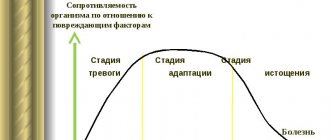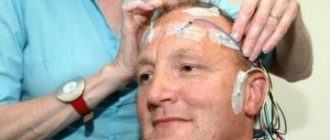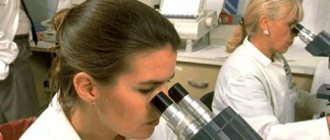prepared by the author of the site based on materials
Guidelines for the diagnosis and management of syncope (version 2009)
The Task Force for the Diagnosis and Management of Syncope
of the European Society of Cardiology (ESC)
Syncope (syncope, fainting) is an episode of temporary loss of consciousness due to general hypoperfusion of the brain. Syncope is characterized by an acute onset and rapid self-regression of symptoms.
The term “collapse” means a sharp decrease in blood pressure, but loss of consciousness is not necessary. In some cases, collapse can be the cause of fainting.
The ICD-10 category for both conditions is R55 Syncope and collapse.
ICD-10 identifies the following types of fainting conditions (“Emergency Therapy”, 2004, No. 1-2 (16-17), A.L. Vertkin, O.B. Talibov):
- psychogenic syncope (F48.8);
- sinocarotid syndrome (G90.0);
- heat syncope (T67.1);
- orthostatic hypotension (I95.1), incl. neurogenic (G90.3) and
- Stokes-Adams attack (I45.9).
The clinical picture of certain types of syncope includes a prodromal period with various symptoms: dizziness, general weakness, dizziness and visual disturbances, indicating the subsequent development of syncope. However, syncope often develops without warning.
Typically, syncope is short-lived, in 90% of cases the duration is 5-22 s. However, in some cases, attacks last longer - up to several minutes.
- Up to 90% of cases of syncope lasting more than half a minute are accompanied by clonic
- convulsions.
- The functions of the pelvic organs are usually monitored
- Pulse is weak,
- Blood pressure is reduced,
- Breathing is almost imperceptible.
(Algorithm for the diagnosis and treatment of syncope at the prehospital stage. Scientific and educational material. Moscow 2011)
After the end of syncope, a rapid and complete restoration of consciousness, orientation and adequate behavior is characteristic. Retrograde amnesia is rare and occurs mainly in older people. Some patients feel general weakness after an attack.
The adjective "presyncope" is used to describe the symptoms and signs that precede the loss of consciousness of syncope, being the prodrome of syncope. Thus, “presyncope” or “lipothymia” refers to the prodromal state of syncope without the subsequent development of loss of consciousness.
For the development of cerebral hypoperfusion, a decrease in systolic blood pressure below 60 mm Hg is sufficient. lasting 6-8 seconds. In addition, syncope can be caused by a rapid decrease in blood oxygenation.
Reflex (neurogenic) syncope
Vasovagal (neurocardiogenic) syncope
- mediated by emotional stress: fear, pain, the sight of blood;
- mediated by orthostatic stress
Situational syncope
- cough;
- sneezing;
- defecation;
- urination;
- swallowing (cold liquid);
- postprandial (after eating);
- manipulations in the hairdressing salon;
- playing the trumpet;
- strangulation;
- lifting weights;
- diving under water;
- stretching exercises.
Carotid sinus hypersensitivity
Atypical syncope (with/without obvious trigger)
Syncope due to orthostatic hypotension
Primary autonomic failure
- primary autonomic failure,
- multiple system atrophy,
- Parkinson's disease with autonomic failure,
- dementia with Lewy bodies
Secondary autonomic failure
- diabetes mellitus, amyloidosis, uremia, spinal cord lesions;
- drug-induced orthostatic hypotension;
- alcohol, vasodilators, diuretics, phenothiazines, antidepressants.
Hypovolemia
- bleeding, diarrhea, vomiting, etc.
Cardiogenic syncope
Arrhythmogenic
Bradycardia
- complete AV block (III degree AV block);
- Wolff-Parkinson-White syndrome;
- sick sinus syndrome.
Tachycardia
- supraventricular;
- ventricular
Long QT syndrome
Channelopathies
Structural heart lesions
- aortic stenosis;
- dissection and aortic aneurysm;
- acute myocardial infarction/myocardial ischemia;
- hypertrophic obstructive cardiomyopathy;
- pathology of the coronary arteries;
- primary pulmonary hypertension;
- pulmonary embolism;
- Eisenmenger syndrome;
- heart valve diseases;
- atrial myxoma;
- arrhythmogenic dysplasia of the right ventricle.
Conditions with partial or complete loss of consciousness, but without global cerebral hypoperfusion
- epilepsy;
- metabolic disorders (hypoglycemia, hypoxia, hyperventilation);
- intoxication;
- TIA in the vertebrobasilar region.
Conditions without loss of consciousness
- functional (psychogenic) syncope;
- drop attacks;
- transient ischemic attacks in the carotid region;
- cataplexy;
- paroxysmal dyskinesias;
- paroxysmal kinesiogenic choreoathetosis;
- paroxysmal non-kinesiogenic choreoathetosis;
- paroxysmal dyskinesias caused by physical activity;
- periodic syndromes of childhood;
- benign paroxysmal vertigo;
- benign paroxysmal torticollis;
- cyclical vomiting.
Other paroxysmal nonepileptic disorders
- levodopa-sensitive dystonia;
- episodic ataxia;
- Sandifer syndrome;
- nodule spasm;
- paroxysmal tonic upward abduction of the eyes in children;
- Benign nonepileptic myoclonus of infancy;
- congenital hyperekplexia;
- Seizures of shuddering;
- stereotypies, self-irritation and masturbation;
- Hyperventilation syndrome.
Syncope is an emergency and requires immediate patient evaluation. In the absence of indications of known medical conditions or medications taken by the patient, the clinical characteristics of the attack provide basic information about the nature of syncope.
Symptoms of individual subtypes of pathology
Each subtype of syncope has its own clinical manifestations:
Vasovagal
It is considered one of the most frequently recorded, the pathogenesis of the disease is a sharp increase in the lumens of peripheral vessels. The source of the attack becomes:
- standing for a long time;
- stuffy room;
- overheating under the sun or in a sauna;
- excess of emotions;
- painful sensations.
When the victim manages to leave the place leading to fainting, the problem is limited to loss of strength. This type of disease goes through stages:
- the first 3 minutes patients feel unwell;
- the second stage of unconsciousness lasts up to 2 minutes, with increased sweating, muscle hypotension, pale skin, decreased blood pressure and a thready pulse at a normal heart rate.
The last period lasts 5-60 minutes, the patient feels severe weakness.
Cerebrovascular
It is formed in the presence of neck pathology and is provoked by sudden changes in head position. Clamping of the artery provokes cerebrovascular insufficiency and loss of consciousness. At the pre-fainting stage, extraneous noise in the ears, flashing of black dots before the eyes, and occasionally a headache attack are registered. During and immediately after fainting, a decrease in muscle tone is observed.
Irritative
It develops after a reflex slowing of the heartbeat associated with irritation of the vagus nerve by impulses coming from receptor zones. Pathological deviation is associated with:
- with duodenal ulcer;
- excessive activity of the bile ducts;
- cardiospasm.
Each type of fainting has its own triggers: the process of swallowing, gastroscopy, pain attack. Patients experience stereotypical short-term loss of consciousness up to 2 minutes, without a preliminary phase.
Cardiogenic and arrhythmogenic
The anomaly occurs in 13% of patients with myocardial infarction. Features of symptoms include:
- cardiogenic collapse;
- deep fainting;
- its repetition when trying to get up.
With MES, there are no warning signs, it is impossible to feel the pulse and listen to the heartbeat, the skin is pale with a slight blue tint. The patient's consciousness is restored after the first heartbeat.
Orthostatic
Develops during the transition from a lying to a standing position. Occurs with hypotension, VSD, weakened or elderly organism. This subtype of deviation is not pathological and does not require specific treatment.
History taking
Character of attacks
In order to determine whether an attack was syncope or another type of paroxysmal state, it is necessary to answer the following questions:
- Was the loss of consciousness complete?
- Was the loss of consciousness transient: short-term with rapid recovery?
- Has the patient recovered completely, spontaneously, and without sequelae?
- Was there a decrease in the tone of the muscles supporting the posture?
If the answer to each question is “yes,” the patient is likely experiencing syncope; if the answer is “no” to at least one of the questions, it is necessary to consider other causes of paroxysm.
Number of episodes
As a rule, benign causes are characterized by a small number of syncope and their rare development. In contrast, dangerous causes of syncope cause frequent syncope.
Associated symptoms
Dyspnea may indicate a connection between syncope and pulmonary embolism;
Angina pectoris - for heart disease; The sudden development of syncope (without a prodrome) is also characteristic of cardiogenic syncope, however, due to the fact that reflex syncope is more common, there are more cases of reflex syncope with a sudden onset than cardiogenic ones.
Focal neurological symptoms are associated with neurogenic syncope.
Blood in stool and vomit, melena are signs of gastrointestinal bleeding.
Involuntary urination and defecation , prolonged course - the epileptic (not syncope) nature of the attack.
However, none of the clinical signs is pathognomonistic; a clinical indication of a certain type of syncope does not exclude the need for a complete examination of the patient.
A more detailed overview of possible causes is given in the table below:
Table 1 diagnostic signs of various types of syncope
| Recommendations | Class | Level |
| VVS is diagnosed when syncope is provoked by emotional stress or orthostatic load and is combined with a typical prodrome. | I | C |
| Situational syncope is diagnosed if it occurs during or immediately after the action of special triggers (triggers) | I | C |
| Orthostatic syncope is diagnosed if it occurs after moving to an upright position and/or the patient has had orthostatic hypotension. | I | C |
| Arrhythmogenic syncope is diagnosed if the following changes are detected on the ECG: | I | C |
| - persistent sinus bradycardia <40 beats/min while awake or repeated episodes of sinoatrial block, or sinus pauses ≥3 s; - atrioventricular block 2nd degree (Mobitz II) or 3rd degree; - alternating blockade of the right or left bundle branches; - ventricular tachycardia or paroxysmal supraventricular tachycardia; - unstable episodes of polymorphic ventricular tachycardia and long or short QT interval syndrome; - malfunction of a pacemaker or artificial pacemaker | ||
| Syncope due to myocardial ischemia is diagnosed if the patient has ECG evidence of acute ischemia, with or without evidence of infarction. | I | C |
| Syncope caused by structural heart disease is diagnosed in the case of atrial myxoma causing valve dysfunction, severe aortic stenosis, pulmonary hypertension, pulmonary embolism, or acute aortic dissection. | I | C |
European Heart Rhythm Association (EHRA), Heart Failure Association (HFA), Heart Rhythm Society (HRS), et al.
Guidelines for the diagnosis and management of syncope (version 2009): the Task Force for the Diagnosis and Management of Syncope of the European Society of Cardiology (ESC).
Eur Heart J 2009; 30:2631.
Clinical characteristics that indicate the type of syncope at initial evaluation
Neurogenic syncope:
- no signs of heart disease;
- long-term course of recurrent syncope;
- development after an attack of pain, a sudden unpleasant sight, sound or smell;
- standing for long periods of time or being in a crowd or in hot rooms;
- a combination of nausea and vomiting with syncope;
- during or after meals;
- connection with head turns or pressure on the carotid sinus area (neck tumors, shaving, tight collar);
- development after load.
Syncope due to orthostatic hypotension:
- after moving to a vertical position;
- temporary association with the initiation or change in dose of vasodilator drugs that cause hypotension;
- standing for long periods of time, especially in a crowd or in hot rooms;
- presence of autonomic polyneuropathy or parkinsonism
- getting up after physical activity.
Cardiogenic syncope:
- established structural abnormalities of the heart;
- history of unexplained sudden death or channelopathy;
- during exercise or in a lying position;
- sudden palpitations just before syncope develops;
- ECG changes indicating arrhythmogenic syncope:
- Bifascicular block (defined as either a left or right bundle branch block combined with a left anterior or left posterior bundle branch block)
— Other intraventricular conduction disorders (QRS interval duration ≥0.12 s)
— 2nd degree AV block, Mobitz I
— Asymptomatic sinus bradycardia (<50 beats/min), sinoatrial block or sinus pauses ≥3 s without taking drugs with a negative chronotropic effect
— Unsustained ventricular tachycardia
— Premature ventricular complexes (QRS complexes)
— Long or shortened QT interval
— Early repolarization
— Signs of right bundle branch block with ST elevation in leads V1-V3 (Brugada syndrome)
- Negative T waves in the right precordial leads, ε waves and late ventricular potentials indicating arrhythmogenic right ventricular cardiomyopathy
- Q waves indicating myocardial infarction
Syncope
Syncope (syncope) is a sudden loss of consciousness, which is accompanied by a decrease in muscle tone. Problems arise due to a sudden decrease in cerebral blood flow.
What is syncope?
This condition does not mean an independent disease, but a symptom characterized by a sharp short-term loss of consciousness followed by spontaneous recovery. After fainting there are no neurological disorders.
Reasons why fainting occurs:
- Organic cardiovascular diseases or heart rhythm disturbances.
- Traumatic brain injuries. Transient ischemic attack.
- Orthostatic collapse contributes to an intense change in body position when quickly rising from a lying or sitting position. It occurs due to the indiscriminate use of certain types of medications that lower blood pressure, with autonomic failure, and vascular dystonia. Sometimes orthostatic collapse occurs in healthy people.
- Hyperventilation of the lungs.
- Pathological vasovagal reflex. Increased activity of the vagus nerve.
- Dehydration or infectious diseases
- Epilepsy
- Drop in blood sugar.
- Prolonged overheating of the body.
- Increased painful syndrome.
- Loss of large volume of blood.
- Intense psychological stress. Sometimes fright may be accompanied by syncope.
- Neuralgia of the glossopharyngeal nerve.
- Mental illness, hysteria.
- High or low blood pressure.
Sometimes it is not possible to determine the cause of fainting. It must be taken into account that everyone experiences syncope at least once in their life. Problems occur in people between 10 and 30 years of age, and the frequency of fainting increases with age.
Diagnostics
The most important clinical significance is given to the description of the attack itself and the circumstances preceding it, which the patient must tell the doctor in detail about. What to pay attention to:
- circumstances preceding the attack (lying down, sitting, standing), activity (rest, during changes in body position, during/after exercise/urination/defecation/coughing/swallowing),
- predisposing factors (stuffy, hot rooms, prolonged standing, on an empty stomach or after eating) or triggers (fear, pain, neck compression or sudden turns), palpitations.
- description of the attack by eyewitnesses (character of the fall, skin color - pallor, blueness, duration of syncope, breathing pattern. Convulsions, tongue biting)
- end of the attack (nausea, vomiting, sweating, chills, disorientation, muscle pain, injury, palpitations, urinary and fecal incontinence).
Non-invasive examination methods
include: medical history (including family history with an emphasis on cases of sudden death, heart disease, fainting, diseases of the nervous and endocrine systems), examination of the patient, laboratory tests, ECG (including exercise testing), Holter monitoring ECG/BP, echocardiography, tilt test, carotid sinus massage, electroencephalography, x-ray. Sometimes MRI or CT is used, consultations are held with a cardiologist, neurologist, psychiatrist and ophthalmologist.
Invasive methods -
as a rule, they are used in hospital settings, more often in the presence of symptoms of cardiovascular disorders. This can be an electrophysiological study of the heart, coronary angiography, venticulography.
First aid
In order for a person to recover from a fainting state without the help of a doctor, you need to do the following:
- Place the patient in a horizontal position, give the legs an elevated position, and turn the head to the side.
- Remove the tie, stretch the collar, belt, provide fresh air.
- You need to splash some cold water on your face.
- Bring ammonia to your nose.
- Call an ambulance if the attack lasts more than 3-5 minutes.
Prevention
A suitable way to prevent fainting is to limit the effect of provoking factors:
- It is recommended to wear looser clothes.
- Monitor blood glucose levels.
- Try to slowly change position from horizontal to vertical.
- Avoid depression.
- Do not abuse alcoholic beverages
- Timely treatment of chronic and acute diseases.









